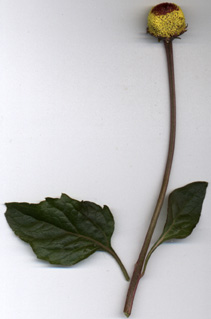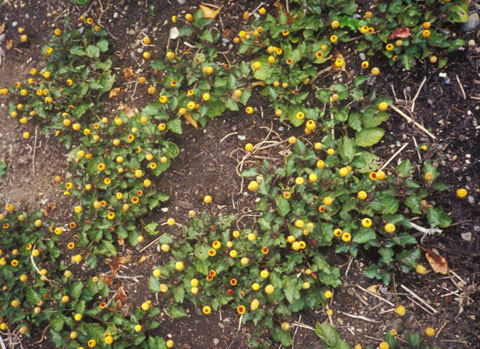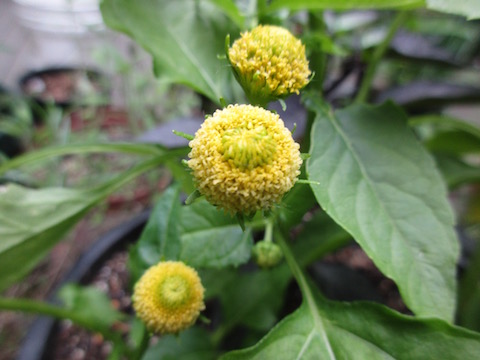Plant of the Month: August 2003
|
| Toothache Plant |
Acmella oleracea (L.) R.K. Jansen 1985
|
= Spilanthes oleracea L. 1767
|
= Spilanthes Acmella var. oleracea (L.) C.B. Clarke ex Hook. fil. 1881
|
COMPOSITÆ (ASTERACEÆ); Sunflower Family
|
| Of many hundreds of different kinds of plants that I eat in salads, only this species causes my tongue and lips to go numb. It is a fascinating plant in several respects, but its numbing or local anesthetic effect is unique, recalling Novocain® used by dentists. |
| If you chew any part of the herb, especially an entire flowerhead, at first your mouth experiences a warm sensation akin to that lent by French Tarragon. Next you sense some shocking acridity, then start salivating as if on command, and finally your mouth loses sensation for a few minutes. The tingling feeling that Toothache Plant causes has been traced to a constituent named spilanthol. |
| If you suffer toothache, this is a good remedy. If you want to have fun, it is swell also --urge your guests to try it and watch their reactions. The plant is not limited to saliva-inducing and numbing properties. Various insecticidal and modest medicinal effects are ascribed to it. Though no cancer cure, it does benefit people in a gently stimulating manner. For more on this you may care to visit the website link supplied below, leading to an article by Richard A. Cech of Oregon. |
| At least in the Seattle area where I live, Toothache Plant is sold sparingly as an ornamental. Some growers call it Peek-a-boo Plant. Though sometimes a perennial herb in tropical regions, in the U.S. it is treated as a summer annual. It cannot handle frosty winters. Nowhere is it known truly wild in a native setting, but only as escaped from cultivation. Acmella oleracea likely originated from the Peruvian species Acmella alba. |
| The plant has been assigned over the years various scientific names, but only a couple of synonyms are cited above. Though mostly called a Spilanthes, since the 1980s the latest expert opinion (of Robert Jansen's six years of intense study) is that Toothache Plant is best considered a member of the closely related genus Acmella. These two genera of the sunflower family (COMPOSITÆ; ASTERACEÆ) are cousins to Bidens, Cosmos, Dahlia, and the like. All members of the genera Acmella (30 species) and Spilanthes (6 species) are more-or-less tropical, and herbaceous. |
| Other common names include Eyeball Plant, Spot Plant, Para Cress (after the Brazilian province), Brazil Cress, Alphabet Plant (from the Flemish ABC Kruid), and Australian Cress. Most plants called cresses are in the mustard family (CRUCIFERÆ; BRASSICACEÆ). Such plants, as well as the familiar round-leaved nasturtium (Tropaeolum majus), ignite our mouths and noses with burning sensations that we term as hot. Think horseradish. But they do not numb us, nor are their effects limited to our mouths. To me, the effect of Toothache Plant is vaguely recalled or hinted at by French Tarragon (Artemisia Dracunculus 'Sativa'), or better still by Water Pepper (Polygonum Hydropiper; Persicaria Hydropiper). If you are unfamiliar with those, you are missing some mighty exciting palate sensations, but chile peppers from the nightshade family (SOLANACEÆ) are in the same general realm of suggestiveness. |
| Toothache Plant is warmth loving. I give it rich soil, mulch, ample watering, and partial sun. It grows all summer, continuing to bloom. Though each flowerhead makes plentiful seeds, I have not had the pleasure of it self-seeding in my garden. Nor have I seen it reseed at the University of Washington Medicinal Herb Garden. In my garden, slugs (or snails or both) eat the leaves and flowers. I cannot blame them because I do the same thing. But if I catch them I will kill them. |
| The plant is bronzy-green, low to the ground and sprawling. Its branching and leafing is primarily in opposite pairs. Inconspicuous white hairs cover it. The leaves are dark green on top, and paler underneath; they are broadly egg-shaped, wavy-edged, rumply, inelegant, and mostly less than 3 inches long. The stems, leafstalks, leafveins and flowerstalks are dark with bronzy or purplish tones. |
The weird-looking flowerheads are set atop elongated stems, sometimes measuring more than 4 inches. The flowerheads begin as squat red affairs; they gradually elongate and turn yellow, still retaining the bloody red portion at the top, as they become chaffy seedheads that contain numerous slender black seeds. The red and yellow floral contrast makes for an effective and endearing sight. A minority of the plants have pure yellow flowers, as seen in my third picture.
Richard A. Cech's article
Back |

Acmella oleracea ; scan by ALJ
|

Acmella oleracea ; photo by ALJ
|

Acmella oleracea pure yellow ; photo by ALJ
|
|
|

